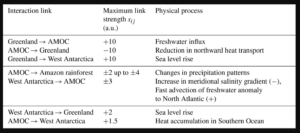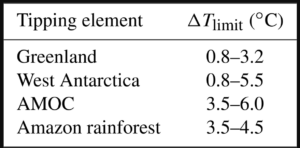When climate tips, ice caps, rainforests and ocean currents shift to a greenhouse world, with no going back. From Berlin, scientist Nico Wunderling reveals tipping points can cascade, bringing extreme disruptions sooner. NASA’s Kimberley Miner reports: as the Arctic thaws under un-natural heat, ancient organisms return to the biosphere, along with banned toxic chemicals and radioactive waste.
Listen to or download this Radio Ecoshock show in CD Quality (57 MB) or Lo-Fi (16 MB)
The COP26 climate summit in Scotland is pretty anti-climactic. Real outcomes were determined a week earlier at the G-20 summit in Rome, October 28th. Leaders representing 85% of the world economic output, and all of the big greenhouse gas emitters, met behind closed doors without climate scientists or activists. All the big corporations and lobby groups were there. Yesterday’s men talked green and did little to nothing to prevent catastrophic climate change.
In the United States, Second President and coal owner Joe Manchin scuttled real climate action. China promised to stop financing more coal power plants in other countries, but will go ahead with it’s own big new coal plant construction binge. India is almost totally powered by coal and Australia is happy to mine more and more of it. The fossil fuel companies explain their green plans to keep pumping carbon into the atmosphere into the 2050’s and beyond.
The only possible substantive change from the G-20 is support for cutting methane emissions from fossil fuel production by 30% from 2020 record high levels by the year 2030. They said nothing about the biggest human source of methane: agriculture. Their plan is a drop in the bucket for ever-increasing methane, 80 times more powerful than carbon dioxide in forcing warming. As you heard in last week’s Radio Ecoshock show, methane is causing about one third of global warming – and the extreme weather already striking around the world.
With the spotlight on methane, the UN Environment Programme and the EU announced a new international project to at least watch where this key gas comes from. The International Methane Emissions Observatory (IMEO) was launched at the G-20 meeting in Rome. But this is no independent methane measuring satellite with real-time public reporting on the Net for us all. Most of the data will come from 74 fossil fuel companies who agreed to a reduction plan. That’s only 30% of oil and gas production. These are the “good” companies. Should we trust them? The IMEO will add scientific data, but that is sparse and underfunded. Sorry, but this U.N. program is no where near what we need. Again.
The harsh truth is: international action to stop the climate disaster is over before it begins. As Reuters newswire reports: “A week before it starts, COP26 has already received the last rites.” The system is committed to extreme failure. That leaves it up to humans, you and I, to change that system and our lives. Brace for impact
In this program we continue to explore what the failure of global leadership means on a living planet that doesn’t care about greenwash.
=============================================================
NICO WUNDERLING – CASCADING TIPPING POINTS SPEED CLIMATE SHIFT
We hear about big climate tipping points like melting ice at the Poles or shifts in ocean currents. Parts of the Amazon rainforest may already be shifting toward grasslands. But what if these tipping points interact, feeding one another? The title of a recent paper from European scientists tells all: “Interacting tipping elements increase risk of climate domino effects under global warming”. This is an Open Access paper, free to you.
The lead author is PostDoctoral Researcher Nico Wunderling. He works with the Potsdam Institute for Climate Impact Research, the Stockholm Resilience Centre and Princeton University. From Berlin, we welcome Nico Wunderling to Radio Ecoshock.

PIK Post-Doc Researcher Nico Wunderling
Listen to or download this 27 minute Radio Ecoshock interview with Nico Wunderling in CD Quality or Lo-Fi
This study was conceived by Ricarda Winkelmann and Jonathan F. Donges, both from the Potsdam Institute and Humboldt University of Berlin. Ricarda Winkelmann was a previous guest on Radio Ecoshock in the show “Worse Than What You Heard” October 7, 2020.
For this research, this PIK team picks four major systems: Greenland and West Antarctic ice melt, the Amazon rainforest, and the Atlantic Meridional Overturning Circulation (AMOC) – known in North America as the Gulf Stream. There are other climate tipping points, but these are (a) major influencers and (b) have been the best studied, with reliable data.
In an earlier 2009 study, Kriegler et al. employed these four tipping elements, plus a fifth, the Pacific Ocean system known as ENSO. We experience ENSO as either the cooling La Nina happening this winter, or heat-releasing El Nino, when many world temperature records were set. The new paper from Wunderling et al. updates Kreigler’s work. The new paper discusses ENSO, and finds that even changes in those Pacific cooling/warming currents would not change their study results.

Source: Wunderling et al, 2021
WHAT DOES IT MEAN?
So what does it all mean? Normally scientists study each big system – and their possible tipping points – separately. But Earth is an interactive system. What if one tipping point sets off others, like dominoes knocking each other down? The results of this study are stunning and worrying.
The paper suggests that melting of the Greenland Ice sheet is often the predominant initiator in past climate shifts. The Greenland Ice starts its long melt at relatively low levels of warming, somewhere just above 1 degree warmer than pre-industrial temperatures. We are already there, and the Greenland Ice is pouring megatons of fresh water into the sea.
From the paper:
“We find that in up to 65 % of all ensemble simulations, the Greenland Ice Sheet triggers tipping cascades…Thus, we call Greenland a dominant initiator of cascades.”
That water has paradoxical effects reaching all the way to South America and even Antarctica. Closer to Greenland, if a great deal of freshwater enters the Atlantic – that can push the Gulf Stream (which is part of the Atlantic Meridional Overturning Circulation or AMOC) further south. A southward change in the Gulf Stream leads to colder winters in Europe, but it also may slow down the heating of Greenland. Several guests on Radio Ecoshock say the AMOC/Gulf Stream is weakening. We can measure that. Wunderling et al. find AMOC is “a dominant mediator of cascades as it does not initiate many cascades.”
Pushing global weather systems further south could also change rainfall in the Amazon Rainforest, leading to more drought and forest loss there. We are already see that in the Eastern Amazon, which has flipped from a carbon sink to a carbon source – but not yet in the whole Amazon. But as the only living system included in this study, the impacts on the great rainforest are not certain yet.
Inexorably, the meltwater in Greenland pushes global sea levels higher. That drives comparatively warm ocean water deeper beneath the floating marine ice sheets of West Antarctica. They melt faster, raising sea level even more. In that way, Greenland ice sheet loss stimulates more and faster Antarctic ice loss too. We are already seeing that as well, with NASA reporting at least one giant glacier is now “unstoppable” as it retreats and melts (Thwaites).
Remember, all the tipping points do not happen at once. Some tipping points do not appear before 3 degrees C. of warming or more. Others, like polar ice sheet melt, take centuries to unfold. There are delay factors in these systems.

Source: Wunderling et al, 2021
When you add it all up, the interactions between tipping points means climate impacts will come sooner than all the model results which considered these big systems separately. That is key information and a huge reason why the world energy economy has to act fast to limit more greenhouse gases in the atmosphere.
====================================================================
UNPLEASANT SURPRISES AS THE ARCTIC MELTS – KIMBERLEY R. MINER
Yes, the COVID-19 pandemic rages on despite all the comforting talk and reopening. The waves move around, currently swamping Russia, Eastern Europe, and parts of Asia. Western Europe appears to be next. About 2,000 Americans are killed by COVID daily, It is high in the UK. No doubt the tens of thousands of people flying to Scotland for the COP26 climate conference will spread more disease around the world.
We see what a single novel virus can do to our lives and the world economy. Now picture a whole age of ancient viruses returning to the surface of Earth. That is just part of the package of threats emerging from the far North, as the permafrost thaws. Let’s investigate.
Now we learn dangerous microbes could be released in the far north, which is warming four times faster than the rest of the planet. Could thawing permafrost could release old diseases like smallpox? Certainly “forever” toxic chemicals are returning out of glaciers and permafrost. So is radioactive waste dumped in the frozen Arctic.
Dr. Kimberley R. Miner specializes in these issues. She led the new paper “Emergent biogeochemical risks from Arctic permafrost degradation.” Kimberley is a Climate Scientist at the NASA Jet Propulsion Lab in Pasadena, California. She is also a firefighter and emergency planner.

Listen to or download this 23 minute Radio Ecoshock interview with Kimberley R. Miner in CD Quality or Lo-Fi
In the permafrost, we are talking about things re-emerging from frozen ground that covers about 24% of the land surface of Earth. It contains frozen life that can revive as the Arctic thaws.
In the Bible, Methuselah was the oldest human, reputed to have lived 969 years. We also give that name to the oldest [non-clonal] tree in the world, the Bristlecone pine – almost 5,000 years old in the mountains of California. Scientists find micro-organisms that can stay in a viable form for tens of thousands of years in bitter cold. They call them Methuselah organisms.
We need to keep our balance in all this new science news, not falling into irrational fears. This study, and other scientists, suggest the chances of a COVID-like disease coming out of thawing permafrost are “improbable”. But others warn “Smallpox – a deadly disease eradicated from the world in 1977 – could return as the frozen tundra of Siberia melts and releases the virus from the corpses of people who died in a major epidemic about 120 years ago, experts have warned.”
Greenpeace is also investigating this.
The permafrost pandemic: could the melting Arctic release a deadly disease?
There been rare cases of strange diseases, infections, and even anthrax coming out of Alaska and Siberia. The cases of anthrax first infect reindeer, so animals can be the vector rather than a direct infection. But so far, it looks like RNA viruses, like COVID and SARS are unlikely to survive long, long burial in Arctic ice and cold.
Again with balance, it is also probable some new life-forms emerging from the frozen North will be helpful.
There is very little in literature provided in Google searches about Methuselah organisms. Miner et al find some with “the ability to maintain viability for a million years or more”. It is not just a matter of surface heat increasing the depth of the active-layer. At the same time microbial communities within permafrost also force change from the bottom up, the paper says. We know very little about the microbes and viruses. “A single gram can contain hundreds to thousands of microbial taxa,”
From the paper led by Miner:
“the persistence of Methuselah microorganisms within modern ecosystems may emerge as an unfortunate surprise. Any re-emergence of Methuselah microorganisms into the modern Arctic has the potential to change the soil composition, vegetative growth and community composition—further accelerating the environmental transition from climate change.”
This new paper “Emergent biogeochemical risks from Arctic permafrost degradation” was published in Nature September 30, 2021. You can read the abstract but the paper is behind a paywall (it costs a lot of money to bypass the journal’s need for revenue).
HAZARDOUS CHEMICALS AND RADIOACTIVITY COME BACK
This new paper is also about humans using the Arctic as a dumping ground which would always be frozen – until it is suddenly not. Chemicals and nuclear waste can come back to haunt us and alter life near the Poles. The dumping, research, and human impacts are greatest and most studied in lands near the North Pole rather than Antarctica.
Humans have cause the deposition of all sorts of heavy metals, bi-products of fossil fuel burning, chemicals, and radioactive materials. Some were intentionally placed in the cold high Arctic as a method of long-term storage. Others dropped on to the icy surface from the atmosphere and became buried there. Chemicals “include organochloride species—polychlorinated biphenyls (PCBs)81–83, dichloro-diphenyl-trichloroethane (DDT), and hexachlorohexane (HCH)”. The authors warn: “the real and future costs of Arctic chemical pollution remain unquantified.”
HEAVY METALS
Some of the most health-dangerous heavy metals are arsenic (As), Cadmium (Cd), and Mercury (Hg). There are large clusters of these heavy metals around former Arctic mining sites, in Russia, Canada, and Alaska. The former Soviet Union was especially determined to develop and populate their Arctic, and Russia still has the biggest cities and population living in the Arctic. There were a lot of mines there, with few to no environmental regulations and no cleanup at all. As the paper says:
“heavy metal contamination from mine waste poses a notable exposure risk to communities and wildlife in regions spanning Scandinavia, Russia, Alaska, Canada and Greenland”.
LEAD FROM LEADED GASOLINE COMES BACK…
These heavy metals are not just concentrated around mining or milling sites, but spread more thinly over most of the Arctic, depending on wind and weather transport systems. The toxic element Lead (Pb) is ubiquitous, coming especially from burning leaded gasoline in vehicles for decades.
The peak for atmospheric lead was in 1970, and the amount declined after that. But the layers that contained the heavy deposition years – are now re-exposed by permafrost thaw during extreme Arctic warming. Lead tends to bioconcentrate, with more accumulating in species higher up the food chain. Both whales and polar bears have been found with alarming amounts of lead. Lead poisoning can lead to loss of brain function, infertility, and damage to nerves in the extremities, like hands and feet.
Fish, plants and birds are also absorbing re-released mercury in the Arctic. Migratory seabirds move it around to new locations further south. Some sea gulls have very high lead levels.
IT IS NOT JUST PERMAFROST BUT ALL ICE RELEASING CHEMICALS
Some of these chemicals are not only in thawing permafrost, but also in thawing ice like Greenland glaciers. Scientists have also found toxic substances from industrial times reappearing as glaciers melt in the Alps. Wherever there has been ice, our emissions of dangerous materials were captured and are now re-appearing.
NUCLEAR MATERIALS – THE HORRIBLE LEGACY
In 1990, the Soviet Coast Guard arrested the crew of the vessel MV Greenpeace. The activists were heading to the remote Arctic island of Nova Zemlya, where nuclear powered ships and all sorts of highly radioactive waste were dumped by the U.S.S.R. They thought eternal cold would store it. I happened to be watching the ship’s emails and was first to catch the S.O.S. from MV Greenpeace being boarded. I phoned Greenpeace executives in Europe in the middle of their night and a saga began – pointing the spotlight on nuclear dangers in the Arctic.
Nuclear materials re-released in a warming Arctic are horrifying. I’ll just let these excerpts from the paper speak:
“Radioactive materials have been sequestered in the Arctic since the beginning of nuclear testing in the 1950s, with additional inputs from accidents, weapons tests and intentional dumping of nuclear waste that have since increased point-source concentrations.”
“Between 1955 and 1990, the Soviet Union conducted 130 nuclear weapons tests in the atmosphere and near-surface ocean of the Novaya Zemlya Archipelago. The tests used 224 separate explosive devices, releasing ~265 megatons of nuclear energy. In the nearby Kara and Barents seas, over 100 decommissioned nuclear submarines were also scuttled. Dispersed contamination from these radionuclides persists in multiple substrates across the region.”
But the Americans did it too, like Camp Century (in Greenland) – “a nuclear-powered Arctic research centre carved into the ice cap > 9m below the ice surface in 1959 by the US Army Corps of Engineers. The research and laboratory facilities were powered by a portable nuclear reactor (Alco PM-2A) and produced considerable nuclear and diesel waste. When the site was decommissioned in 1967, all wastes were left below the accumulating ice, which is now rapidly receding (~268 tons of ice loss per year)…” Oh, and a bomber carrying nuclear warheads crashed and smashed on the Greenland glacier near Thule in 1968. All that is still there.
The paper says: “Research from the 1990s into the transport and uptake of 137Cs [Cesium 137] suggested that harmful levels of radioactivity may be present until the year 2500, but critical analysis has not incorporated recent changes from climate warming.”
With all these everlasting toxic chemicals, heavy metals and nuclear materials, rapid warming of the Arctic has brought them back to the surface, where they can be moved through increasing pond and stream systems. Some will go into the Arctic ocean. All can be transported long distances by migrating birds, wandering herds of caribou, and fish. The wind can pick them up and carry them who knows where.
It is even conceivable, these scientists say, that emerging particles in a warming Arctic could change the amount of cloud cover over the Arctic. That could have a MAJOR impact on Earth’s energy imbalance, and so hasten climate change all over the world. A lot more study is needed on this.
THE FINAL KICKER: ANTIBIOTIC RESISTANCE?
Some of the organisms found in Siberia are resistant to antibiotics, even though they have never been in contact with antibiotics. Some were over 100,000 years old. The authors warn:
“concerns have been raised about the potential for the exchange of genetic material between antibiotic-resistant permafrost microorganisms and contemporary bacteria to create new antibiotic-resistant strains.”
MORE HUMANS IN THE ARCTIC INCREASES RISK OF SPREADING NEW STUFF
Miner et al write:
“The probability of direct anthropogenic transport increases with increased tourism, commerce and resource extraction in the warming Arctic. Reductions in sea ice enable cruise ships and commercial operations to bring more visitors to the north. Over 1,000 settlements—including those focused on resource extraction, military and scientific endeavours – have been erected on permafrost in the last 70 years. This growing non-resident population creates more opportunities for both intentional and accidental transport of Methuselah microorganisms and viruses throughout the Arctic and to lower latitudes.”
Note: a new life form could be transported by boat or plane passengers accidentally. Or they could be brought South to labs for study – whether for academic study or military purposes. Some methuselah organisms have already been brought back to southern labs (closer to where most Ecoshock listeners live). Theoretically Level 4 Biosafety Labs can do this safely, but accidents happen… (cue in the Wuhan Lab theory).
THE REAL STORY MAY TAKE A COUPLE OF GENERATIONS TO APPEAR…
“The worst effects of known toxins on human populations in the Arctic may be yet to come. The increasing load of chemical mixtures from permafrost can bioaccumulate across generations, weakening the immune system and increasing vulnerability to new pathogens.”
Plus: the front line for this experiment in polar warming are the indigenous people in North America, Scandinavia and Russia. It is again, another very unfair impact of global warming on those who had the least emissions of carbon, chemicals or nuclear materials. In this and coming generations they will pay the first price. The first new disease may appear not in southern China, but in the Arctic where we have practically no monitoring and little health care.
RELATED PAPER, COVERED BY RADIO ECOSHOCK
Abrupt Permafrost Thaw & Repetitive Heat Waves
Posted on June 5, 2019, by Radio Ecoshock
A faster permafrost thaw means even the worst scenarios underestimated the pace and severity of climate change. Canadian scientist Merritt Turetsky explains “abrupt permafrost thaw”.
PREVIOUS APPEARANCE BY KIMBERLEY MINER
Kimberley Miner was on the show in November 2018.
SEE ALSO THIS ARTICLE IN SCIENTIFIC AMERICAN
Deep Frozen Arctic Microbes Are Waking Up
Thawing permafrost is releasing microorganisms, with consequences that are still largely unknown
By Kimberley R. Miner, Arwyn Edwards, Charles Miller on November 20, 2020
THE LATEST U.N. CONFIRMATION OF FAST ARCTIC WARMING
Scientists writing reports for the United Nations have been cautious, too cautious, for the past 25 years. Under the heat gun this year, the latest U.N. report finally admits we will pass 2 degrees of warming before the year 2100. We are heading over the edge.
Confirming our interview with Kimberley Miner, the October 22 U.N. Press Release headline is stark: “Polar Changes Risk Unstoppable – and Permanent — Climate Breakdown, Warn Scientists”. They say, quote: “Irreversible melting of the polar ice sheets and unstoppable increases in sea level will result from the continued current growth in human carbon dioxide (CO2) emissions”. (I got this Press Release in my email, but it has since disappeared from the Net…)
Yes, like Aliens arriving, new methuselah life forms are emerging from long-frozen ground in the Arctic. Some are naturally immune to antibiotics. Others might help other living things, even help us. It’s a new frontier as deep time comes to the surface of now, thanks to heating up the Arctic.
The old reactors and waste left to freeze in the Arctic by America and Russia are coming back, by land and sea. The chemicals we thought were banned in the 1900’s are coming back, like PCBs. In Siberia, fields that were flat enough to play sports are now full of bubbled up soil interspersed with boggy channels. The underground has collapsed, as former ice thawed and drained away. Whole forests of trees are falling over. Locals, call them “Drunken Trees”.
The longest web of aging pipelines in the world are built on permafrost. Those are in Alaska but especially across Russia. As the ground collapses or bubbles up, the pipelines are twisted, then break open, pouring oil or gas into fragile living systems. And Europe worries again about getting enough gas to keep industry, heat, and the lights on. Expect this on-going story, until localized renewables deliver enough power for energy-reduced lifestyles.
This decade looks stormy in many ways.
Remember when guests used to say, back in 2007 or 2010 shows, “We have ten years left to stop climate change.” Well, time is up. We are not making it. Maybe it is time to be a “doomer”. At least we can be friendly, peaceful doomers. Maybe we can try to slow down the juggernaut intent on wrecking the future. You may help usher in the new age. You may be among those midwives of a new age being born.
I’m Alex Smith, grateful for your support for Radio Ecoshock.
Excellent knowledgeable probing questions as ever Alex. One telling comment from Nico Wunderling is that he is unable to quantify the interaction between self reinforcing feedbacks (eg permafrost melt/methane) & the perceived main tipping points.
This is disturbing because some “notable” climate scientists now dogmatically rely on their latest super climate models in declaring that NetZero is the “off switch” which stops further global heating.
That’s difficult to believe whilst there is a huge ocean latent heat source (from absorbing 90% of greenhouse gas warming) which will, apart from changing ocean currents, dissipate over decades+ – thus generating even more atmospheric warming & producing yet another earth system state ?